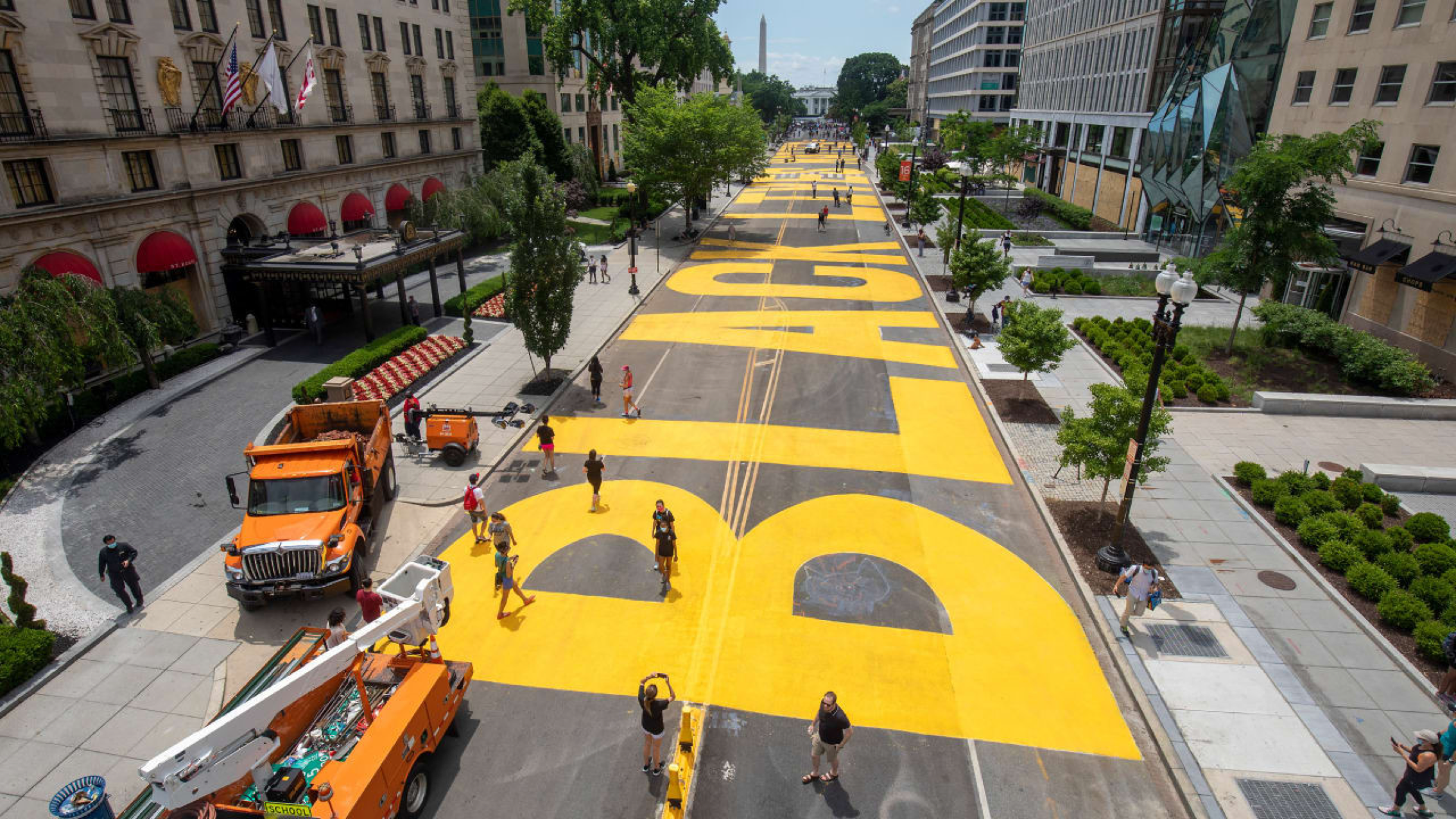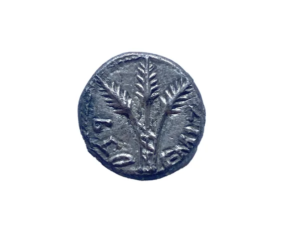Keyonna Jones received the call from a fellow artist one Thursday night in early June, and she agreed to the job without knowing what or where she’d be painting. The friend told her it would be a mural somewhere in her hometown of Washington, D.C.
“When they first called me, they didn’t have any details other than there was a budget,” Jones says. But that was enough to bring her on board. The mother of two had recently shut down the nonprofit organization she founded, Congress Heights Arts & Culture Center, due to COVID-19. Money had been tight since.
That evening at 8 p.m., she hopped onto a Zoom call with seven other artists, and that’s when she found out what the project would be. “It was going to be Black Lives Matter, in front of the White House, spanning a few blocks,” Jones says. The project, ordered by D.C. Mayor Muriel Bowser herself, would have to start at 3:30 a.m.. “I was like, whoa, this is pretty serious,” Jones says. “I start going into shock, that I’m going to be doing this like a ninja in the middle of the night.”
Plus, it was raining.
Despite the odds, they got it done. And almost immediately, the mural (whose all-cap yellow letters can be seen from space) became the most talked about work of art in years. Many people, at least initially, praised its bravery. And yet within hours of Mayor Bowser revealing the painted mural to the world, leaders at Black Lives Matter D.C. promptly denounced it, calling it a “performative distraction from real policy changes” and a way to “appease white liberals.” The sentiment is simple: If you support the mural, you don’t really support the movement. (Black Lives Matter’s national office declined to comment for this article.)
For all the criticism, many other cities have followed suit, and now there are similar murals in Seattle, Charlotte, Brooklyn, Los Angeles, Dallas, Denver, and more. They undeniably capture a historic moment. But they also raise thorny questions about whether public art can be a catalyst for change—or merely a distraction.
THE DECISION TO MAKE THE MURAL
According to the D.C. Mayor’s office, the inspiration for Black Lives Matter Plaza was a direct response to President Trump enlisting the national guard firing pepper balls at protesters for a photo opportunity. She ordered that two blocks on 16th Street be painted and renamed to embrace the spirit Black Lives Matter.
“Mayor Bowser wanted to use art to make a statement at the site where peaceful protestors were attacked to create a photo op on Monday,” writes John Falcicchio, chief of staff for Mayor Bowser in a statement to Fast Company. “Knowing that Black Lives Matter demonstrations would grow this weekend, Mayor Bowser told the team it was important to show those who would assemble that this would be a safe place.”
The project came in for a crash landing to be ready by Friday. When Jones showed up in the middle of the night, the city’s Department of Public Works (DPW) had street sweepers wipe away the rain, which had stopped around midnight.
It was slow going. As Jones tells the story, they had just four gallons of yellow paint, and it took three hours to get the first “B” in Black Lives Matter measured out. The paint ran out before the “L” was done. Then around 7 a.m., the DPW showed up with more yellow paint, but it was a slightly different yellow, so the crew had to repaint the B and L before moving on. Worried they might still run out of paint, they watered down cans as they went.
Onlookers asked what the team was doing. At first, they didn’t know if they could say. Eventually, they admitted it was an order from the mayor’s office. Citizens began to ask if they could help, and so DPW employees found more brushes, and they stripped out of their uniforms to paint as well. The original art team took on a supervisor role to manage the volunteer crew. “That was not planned, but it was quite moving to see,” Falcicchio says.
Jones echoed the sentiment. “I think the universe just opened up,” she says. “I’ve done a few protests, I did the Million Man March when it returned. I’ve been in so many spaces and the energy felt so different.”
Local news showed up. Then national news showed up. The mayor arrived for a press conference. “And that’s when we realized she was renaming the whole plaza,” Jones says. “That’s when we were like, whoa, this is really, really, really big.”
The next day, Black Lives Matter D.C. adjusted the mural, erasing stars that had been included of the D.C. flag and adding “defund the police.”
THE MODERN HISTORY OF MURALS
Murals have long been a tool of persuasion. The modern mural as we know it is rooted in what was once considered radical, leftist politics.
The medium can be traced back to Mexican painter Diego Rivera, who revitalized the mural in the early 20th century. As Robert W. Cherny, professor emeritus of history at San Francisco State University explains, Rivera learned mural-making by studying art of the old masters from the Renaissance in Europe. They made murals by more than just painting on a wall. They used a technique called fresco that requires a layer of wet plaster on a surface, which you paint while the plaster dries. The technique melts the image into the surface of a building, turning it into a piece of the urban landscape.
Rivera and his contemporaries, such as José Clemente Orozco and David Alfaro Siqueiros, were leftists, and used the medium to re-depict Mexican history. At the Palace of Cortés, a palace built by Spanish conquistadors in 1523 after claiming the land from the Aztec empire, he painted one of his most defining works. Commissioned by the U.S. Ambassador to Mexico, the piece depicted the history of Mexico since Spain’s invasion—depicting how conquistador Hernán Cortés met with locals, started a war, and enslaved Mexicans to manage plantations and even build the very palace the work was exhibited in. The mural ends with the Mexican Revolution, as revolutionary leader Emiliano Zapata strides alongside a white horse taken from the conquistadors. “That’s where Rivera found his great subject matter, where he painted the whole history of Mexico but around repression of [indigenous] people,” says Cherny.
American artists began to copy Rivera’s work. As part of the New Deal in the 1930s, the government hired artists to paint murals in public buildings across America. But whereas Rivera had worked without censorship, New Deal murals couldn’t be blatantly political. Instead, they tended to depict positive aspects of capitalism and the expansion of the West (notably erasing Native Americans in the process). A frequent motif was the blue eagle of the NRA, the best known symbol for the New Deal. “The artists liked the fact the federal government was giving them work, obviously, and they sometimes subtly, and sometimes not so subtly, were promoting the New Deal,” says Cherny.
World War II pulled the U.S. out of the Great Depression, and the New Deal ended. But murals stuck around as an American art form, spurred on by local communities, and especially Latino and Black artists, throughout the 20th century. Today, many big cities, like D.C., provide a budget for murals.
COMMUNITIES CLAIMED MURALS FOR THEMSELVES
At their most fundamental, murals can help communities create meaningful public spaces. In the early 1900s, Mexican immigrants began moving to a community in San Diego called Logan Heights—many of them fleeing the Mexican Revolution. By the 1950s, the government zoned the residential area with industry, bringing factories and pollution. Then in the 1960s, the city split the community in half with a freeway, tearing out thousands of homes in the process.
“In response, the community protested the placement of this highway interchange, and even though they weren’t able to block the freeway, they demanded the right to paint murals on the highways,” says Eric Avila, a professor and cultural historian at UCLA. These murals became a state historic landmark, but more importantly, the created the framework for an 8-acre gathering space under the freeway called Chicano Park. “They created an almost kind of sacred space where there are annual festivals and gatherings to celebrate historic moments in Mexican and Mexican American history,” Avila continues. “There are car shows, community festivals. And it’s all housed in this infrastructure that has been covered in these murals by Chicano, Central American, and indigenous artists as well.”
Avila sees a parallel to the D.C. mural: “It’s a very similar thing to what’s happening in D.C.,” concludes Avila. “It’s reappropriating public space in the name of inclusion, diversity, and equality.”
A similar story occurred in Bronzeville, Chicago, in 1967, when the muralist William Walker talked to the owner of a local TV and radio shop, asking if he could paint a mural for the Organization of Black American Culture. What he created, alongside many volunteer artists who had never painted murals before, was the Wall of Respect, with portraits of inspiring Black figures including Malcom X, Muhammad Ali, and Harriet Tubman.
“In the Southside of Chicago those days, you didn’t even see [Black portraits except on] billboards with liquor or cigarettes with Black faces on them . . . it was a real intervention to put up a monument to Black heroes and heroines,” says Rebecca Zorach, professor of art and art history at Northwestern University. The Wall of Respect was more than a symbol. It became a rallying point for Civil Rights activists, an ad hoc community space, where they convened when visiting Chicago. The building somehow caught fire in the early 1970s, so the city demolished it, along with the wall.
A lingering question about Black Lives Matter Plaza, to Zorach, seems to be whether it serves as a communal rallying place, or represents a gentrification of the Black Lives Matter movement. She points out that Chicago itself has been criticized over the past 10 to 15 years, as the city has commissioned street artists to decorate the rapidly gentrifying southside Mexican community Pilsen. “There’s a sense . . . it’s a sign of appropriating what was a more grassroots movement to create an image that’s about attracting white suburbanites to live in a neighborhood,” Zorach says.
A MURAL IN D.C. IS DIFFERENT
The Black Lives Matter mural in D.C. is unique from these historical precedents in a significant way: Its identity is inherently complicated by the fact that it was painted in our nation’s capitol, a capitol that is largely Democratic and features an ever-so-slight majority of 46.4% Black and African American people who live among Republican federal government workers.
“D.C. is different than any other place in the U.S., politically,” explains Ceasar McDowell, special advisor to the MIT Media Lab and professor of practice in civic design. “So one could look at it and say this is actually, you know, a governmental institution that in of itself has been struggling, just like people living in it who are mostly Black, and this is a way of speaking out and acknowledging its own struggle. It’s very different than other cities like Atlanta or Detroit. D.C. is . . . a place where the president can call out the National Guard, and the D.C. mayor can’t do anything about it.”
That makes the D.C. mural both more vulnerable to critique (how effective can a mural really be when it answers to the commander in chief down the road), and more radical than other, similar efforts. “In this country, we have powerful language critique,” McDowell says. “We know how to talk about what’s wrong with something, how to look at it and take it apart. What we don’t have a language for is transition, and in the transitional space it’s really hard . . . You have the work at undoing the thing that you have to contribute to in order to undo it.”
BLACK LIVES MATTER IS A MOVEMENT IN RAPID TRANSITION
In the two weeks since Bowser commissioned the D.C. mural, similar Black Lives Matter street murals have cropped up throughout the United States. Jones, as the only artist to break anonymity on the D.C. project, has fielded emails from protesters explaining they are trying to set up similar murals in their own cities.
They’re also facing criticism. Here’s one Twitter user’s response to Flint, Michigan, painting a mural on Martin Luther King Ave:
This tweet, which was liked more than 200,000 times, cuts to the heart of why art can seem distracting at best—and dangerous at worst—in the midst of rampant inequity and injustice. Why sink resources into a symbol when there are so many systemic problems that need to be fixed and so few resources to go around?
Eeshyia King, a Flint resident and one of the volunteers who helped paint the mural with the Black Lives Matter Flint chapter, defended the art. “I think that it is a really big statement in Flint just because the whole basis of the Black Lives Matter movement starts with the system,” she says. “And in a place like Flint, all of our issues have come directly from our government.”
King, alongside DeWaun E. Robinson, BLM Flint Chapter Lead, insists that this wasn’t a city government photo op. It was a community-funded project, created with volunteer labor. The team got approval from the city beforehand, and if they hadn’t? The mural probably would have been painted anyway. “The Black Lives Matter movement goes hand in hand with the water crisis,” she says.




